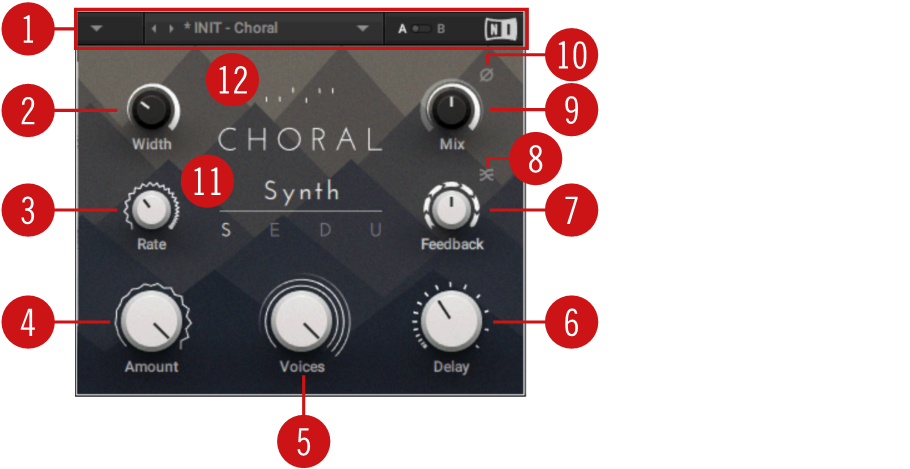CHORAL
CHORAL enriches sounds by adding spatial movement and giving them an ensemble-like quality. This section includes a general note about flanger effects and an overview of the FLAIR plug-in.
In this chapter you can learn about CHORAL. It includes a general note about chorus effects and an overview of the CHORAL plug-in.
About Chorus Effects
Choruses are used to enrich sounds by adding spatial movement and giving them an ensemble-like quality. They are based on short delays, with built-in modulation of the delay time. The delays produce copies of the original sound that vary in timing and, as a side-effect of the delay time modulation, pitch. This way a chorus adds space and body to the sound as if it was played from multiple sources at the same time. The results range from subtle shifts in timbre to extremely lively textures with a wide stereo image.
As one of the most commonly used guitar and studio effects, various implementations of the chorus have found their way into studio rack processors, guitar pedals, and synthesizers. CHORAL is inspired by synthesizers and studio rack processors from the seventies and early eighties. On these devices, the chorus parameters are hidden. CHORAL gives you enhanced control with parameters that allow you to customize the effect with minimal effort.
Overview of CHORAL
CHORAL features four distinct chorus modes, ranging from the subtle sound of classic studio rack processors to the large ensemble sound of early string synthesizers. The effect is produced by up to three pairs of delays, called Voices. All chorus voices preserve the input signal’s stereo image, but can also be panned to further widen the sound (Width parameter). The internal modulation system affects each voice differently, thus preventing obvious modulation repeats. Further expanding on the original concept of a chorus, the Scatter mode allows you create reverb-like sounds, avoiding the metallic quality that many choruses exhibit with high Feedback settings.

Header: Provides global functions related to preset management and plug-in behavior. For more information, refer to Header and Presets.
Width: Pans the chorus voices in opposite directions, widening the stereo image. When Width is set to 0, the input’s stereo image is preserved.
Rate: Adjusts the speed of modulation, from slow pitch changes to fast vibratos. This becomes more pronounced as Amount is increased.
Amount: Adjusts the amount of modulation applied to Delay, altering the delay times of the chorus voices. Due to the configuration of the delays, this also changes the pitch of the chorus voices, creating the classic chorusing effect.
Voices: Fades from one to three chorus voices. Increasing the number of chorus voices adds a dense and ensemble-like quality to the sound. The modulation affects the second and third chorus voice differently from the first, resulting in a wider and livelier sound.
Delay: Adjusts the delay times of the chorus voices, allowing you to change the spatial depth of the sound. This parameter strongly interacts with Feedback.
Feedback: Adjusts the level of the feedback signals from the outputs of the chorus voices to their inputs, creating a more sustained and spacious sound
Scatter: Enables a special feedback routing for the chorus voices that introduces reverb-like behavior.
Mix: Blends between the dry signal and the wet signal by means of an equal-power crossfade.
Invert: Changes the sound characteristic of the chorusing effect by inverting the effect signal.
Mode:Switches between four chorus modes, each with its own sound characteristic and modulation behavior.
Synth: This mode is inspired by the choruses of polyphonic synthesizers from the late seventies and early eighties. Its sound characteristic is dark and vintage. The modulation behavior is tuned for rich and dispersed sounds.
Ensemble: This mode is inspired by the choruses of string synthesizers from the seventies. Its sound characteristic is warm and lush. The modulation behavior is tuned for animated and lively sounds.
Dimension: This mode is inspired by the choruses of studio rack processors from the early eighties. Its sound characteristic is bright and transparent. The modulation behavior is tuned for wide and consistent sounds.
Universal: This mode is a more generic chorus implementation. Its sound characteristic is clean and modern. The modulation behavior is tuned for a range of sounds from consistent to lively, depending on the number of Voices.
Display: Shows the number of Voices and their Delay spacing, including the Amount and Rate of the modulation.